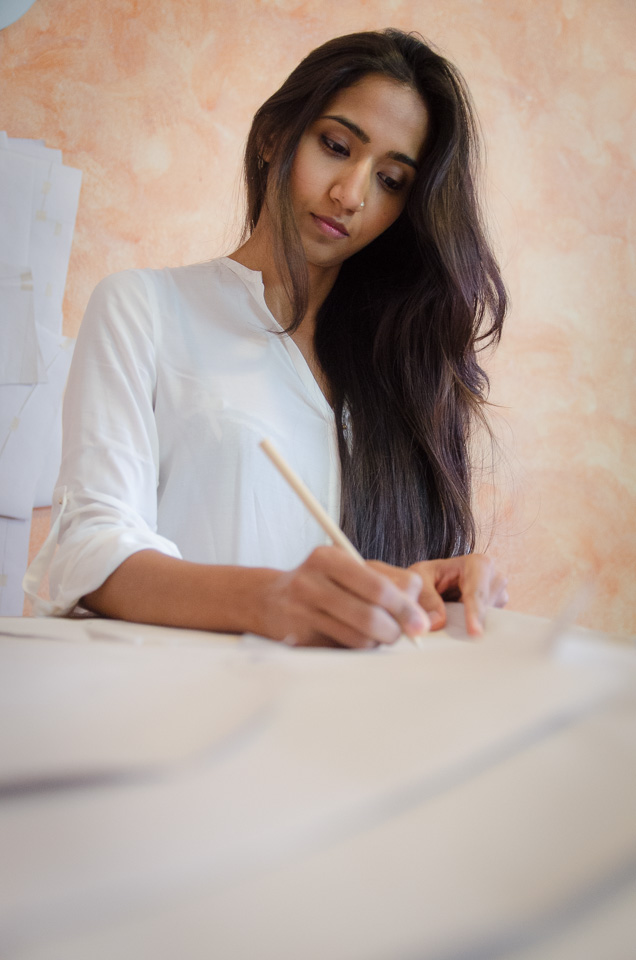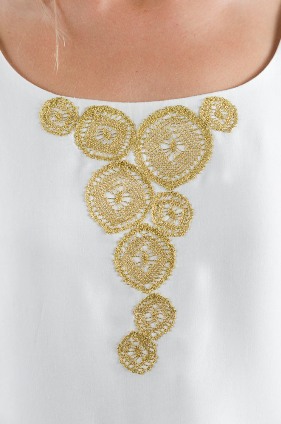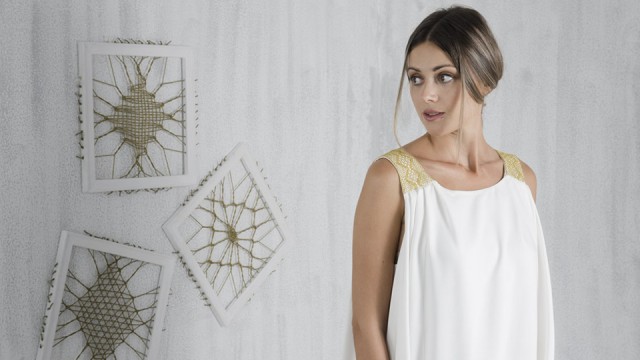Akanksha Sharma is a young fashion designer who 'dared' to make her debut away from the fashion capitals of the world. We met her in her small workshop at the historical district of Agia Triada where she created her own label, Ariadne’s Thread, with the support of her family and friends. Inspired by traditional "kopaneli" (bobbin lace) techniques, she designed her very first collection for spring-summer 2015. Every one of her completed pieces are made with skillfulness and extreme attention to detail, and - we may confirm- the fabrics used feel heavenly on the skin!
 What’s your background in fashion design?
What’s your background in fashion design?
I specialized in Indian traditional textile design during my Bachelor’s in Home Economics from University of Delhi. It is through this that I developed an appreciation towards handicrafts. After obtaining my Bachelor’s degree, I went on to pursue a Post Graduate Diploma from Pearl Academy of Fashion in New Delhi, one of the finest fashion design schools in India. After gaining valuable experience within esteemed fashion labels for a year in New Delhi, I obtained a Master’s degree in Fashion Design and Atelier in the University for the Creative Arts in England with a scholarship. The following year I worked in a high end fashion label based in London, before moving to Crete for good.
How long have you been living in Crete? How do you find life here?
It’s been three years now. As I come from the capital city of India, New Delhi, a place which is constantly growing in population, buildings and traffic, I could easily say that Crete has a much more relaxing atmosphere. I really like that whenever my family and I go out in the city of Heraklion we always find people we know, so the world seems smaller; and hence human relations are warmer here in comparison to a bigger city like Delhi or London. Even though I live in the center of the city, I feel I am close to the nature because it is just a matter of half an hour driving to reach a place surrounded by nature, whereas the distances within Delhi are huge.
Can you describe your ‘fashion philosophy’?
For me fashion should always have a purpose, be it using sustainable fabrics to preserve our environment or dedicating a collection towards spreading a social message or pushing the boundaries of what is fashion itself by applying advanced technological methods into the making of a single garment. There should be a personal vision rather than just cutting a fabric into a silhouette, following trends made by someone else. My philosophy of fashion revolves around the concept of the handmade. It is a privilege to own a piece of handmade cloth, whether it is in a form of a table runner or a garment, it should be treated like a jewel. It excites me to observe the work of an artisan and appreciate the kind of devotion and skill it takes to make an entirely organic piece of clothing. Being able to promote such skills is the philosophy I want to follow in my work.
What can you tell us about your first collection? What were your inspirations?
My label ‘Ariadne’s Thread’ is dedicated to the promotion of the handmade textiles of Greece and we made a beginning by creating a small collection of women’s occasion wear in classic silhouettes, focusing on reviving the craft of Kopaneli (bobbin lace). It is my (and my team’s) intention to give life to this craft which is struggling to survive by fusing it with clothing.
Fashion is a strong tool for creating awareness, especially among the young crowd. This is why we want to provide economic support to artisans and generate awareness about the craft of bobbin lace, reclaiming it as a professional practice. The collection comprises of garments with impeccable finish and fit. It is my desire to attract my label’s customers through the craftsmanship and quality that my highly skilled team takes pride in. Hence, have the buyers of my product to consider it as their prized possession which can stay stylish for life and can be passed on to generations.
 How did you choose the traditional art of ‘kopaneli’? How did it inspire you to use it in your collection?
How did you choose the traditional art of ‘kopaneli’? How did it inspire you to use it in your collection?
For my first two years here in Iraklion, I observed my mother-in-law practice and teach Kopaneli. India boasts countless traditional techniques of textile art, but I have not come across one like Kopaneli. Obviously, it looked so beautiful and intricate to me. So I got very interested in knowing more about it. Even though no one knows the exact origin of Kopaneli, it had nonetheless become an integral part of Greek handicrafts culture. I soon realized that a lot of young Greeks didn’t even know what Kopaneli is. Considering my background, I feel very strongly for anything handmade and it breaks my heart when I see a beautiful craft dying slowly because it is considered to be just a hobby limited for housewives and also limited in making only the table tops or table runners. Kopaneli was used more dynamically in the past, so why not now. Designing garments keeping Kopaneli in mind came naturally to me. I feel that if this craft is combined with clothing in a not so obvious manner, then people will notice and appreciate Kopaneli art and they might wish to learn it or support the very few existing artisans by buying their creations.
From where do you get your materials? (fabrics, ect).
I am proud to say that we use organic, environmentally friendly fabrics made from the fiber of bamboo and soya bean which are sourced from India. Other than that, the collection is 100% made in Greece.
For me fashion should always have a purpose, be it using sustainable fabrics to preserve our environment or dedicating a collection towards spreading a social message or pushing the boundaries of what is fashion itself
Do you find similarities in Indian & Cretan traditional clothing / arts? Can they be combined to dress modern women?
Yes of course, there are a lot of similarities in some of the regional Indian and Greek traditional clothing. Considering the ancient history that Greece and India share, starting from around 300 BC when Greeks reached northern India, and the flourishing trade route between the two countries, there must have been a lot cultural exchange happening, leading to the similarities. There are some similar embroidery techniques that I have witnessed in both countries along with the traditional dressing of both men and women. Although, somewhere down the line Greece has unfortunately lost the charm of wearing their traditional clothing in day to day life or even occasionally. It is rather considered to be a ‘costume’. Whereas, in India traditional clothing is deeply induced and has developed to the point that it is considered to be stylish and fashionable. Fusing Indian and Cretan techniques of creating textile can give birth to some very fashionable and elegant clothing for modern women.
What’s the ‘target group’ of your collection?
The collection has been carefully designed to accommodate the wider age group of women. We have dresses that would look good on a 25 year old woman as well as on a 50 year old lady. It is targeted towards someone who has an appreciation towards handicrafts in general and someone who wants to own an exclusive piece of handmade garment. I am positive that it will catch the attention of tourists visiting Greece as well.
 Do you think you can be a successful fashion designer in a ‘remote’/folklore place like Crete?
Do you think you can be a successful fashion designer in a ‘remote’/folklore place like Crete?
It is challenging, but I feel that in the era of globalization the world has become smaller and far more accessible compared to two decades back. I feel one can live in any corner of the world and conduct their business without problems if they have access to the right tools. You just have to learn to develop a system around you that works.
Though I do miss the bustling bazaars and wholesale markets of New Delhi and London, they are two resourceful places for me. Coming from India is to my advantage because I have my family there, so I always feel a lot of resources are within my reach. As far as networking is concerned, with the aids available over the internet it is fairly convenient to set up business even in a remote place like Crete.
Do you plan to present a fashion show here in Crete (or in Greece in general)?
I am generally not very keen on having fashion ramp shows. I am more inclined towards setting up my collection in an unusual exhibition or in a form of a fashion performance. For this particular collection of spring-summer 2015, I had organized an exhibition in November 2014, which received an overwhelming response from the people of Heraklion.
Any future plans?
Apart from continuing the revival of Kopaneli art, the future vision is to slowly expand and explore various creative possibilities and built a brand name known for its exclusivity and fine work.
* We would like to thank Nikitas Almpanis for providing all the photos featured in this article!






